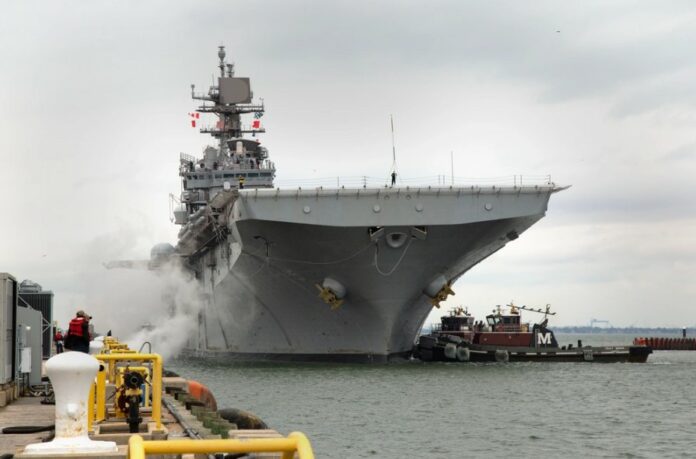NAVSEA is the largest of the Navy’s six system commands, responsible for the procurement, maintenance and modernization of ships, submarines and systems for the U.S. Navy. NAVSEA’s Technology Office is leading multiple areas of research and development in evaluation of AM equipment, using data not only from deployed assets, but also shore side lab activities, to gain a critical understanding of how the equipment will perform under shipboard conditions. These evaluations will ensure that the current and future shipboard implementations of this equipment are fabricating parts repeatedly and reliably, thus allowing Sailors to address an increasing number of applications.
In a recent milestone, the crew of USS Bataan (LHD 5), supported by the Naval Sea Systems Command (NAVSEA), achieved the first metal 3D printed part fabrication and replacement for a de-ballast air compressor (DBAC). The fabrication was completed in only five days, using the ship’s permanently installed metal 3D printer.
The part, a sprayer plate, is part of a DBAC which is used to force pressurized air through saltwater tanks and discharge the accumulated saltwater. The tanks are filled to lower a ship’s draft for amphibious operations. Producing the sprayer plate while at-sea enabled the ship to mitigate the time spent obtaining a replacement assembly.
The manufacturing portfolio includes the Phillips Additive Hybrid system, which integrates a Meltio3D laser metal wire deposition head on a Haas TM-1 computer numerical control mill. The Haas TM-1 platform has been proven to operate reliably in an afloat environment aboard several aircraft carriers. Integrating the Meltio 3D deposition head with the Haas TM-1 provides both an additive and subtractive manufacturing capability within the same system, increasing efficiency and reducing waste when compared with typical machining.
The repair effort, led by Machinery Repairman First Class Mike Hover, began by creating a computer aided design (CAD) model of a sprayer plate from a functional sprayer plate from one of the ship’s other DBAC systems. After creating a preliminary CAD model, Hover leveraged NAVSEA’s ‘Apollo Lab’ construct established for engineering and fleet support and training.
Bryan Kessel, a mechanical engineer at Naval Surface Warfare Center, Carderock Division, refined the CAD file, worked with JHU APL to develop the software instructions to guide operation of the metal 3D printer and securely transferred those instructions back to the ship to produce and install the sprayer plate.
“This success story shows the self-sufficiency we can achieve when our Sailors are provided with cutting-edge technology,” said Rear Adm. Joseph Cahill, commander, Naval Surface Force Atlantic (SURFLANT). “The impact technology like this can have on operational readiness, particularly in a combat environment where logistics capabilities will be challenged, is critically important.”
Remember, you can post free of charge job opportunities in the AM Industry on 3D ADEPT Media or look for a job via our job board. Make sure to follow us on our social networks and subscribe to our weekly newsletter : Facebook, Twitter, LinkedIn & Instagram ! If you want to be featured in the next issue of our digital magazine or if you hear a story that needs to be heard, make sure to send it to contact@3dadept.com


